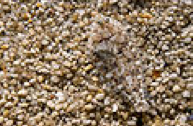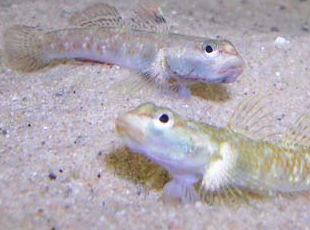|
BENTHIC FISH
Benthic fish, sometimes called groundfish, are denser than water, so they can rest on the sea floor. They either lie-and-wait as ambush predators, maybe covering themselves with sand or otherwise camouflaging themselves, or move actively over the bottom in search for food. Benthic fish which can bury themselves include dragonets, flatfish and stingrays.
Flatfish are an order of ray-finned benthic fishes which lie flat on the ocean floor. Examples are flounder, sole, turbot, plaice, and halibut.
The adult fish of many species have both eyes on one side of the head. When the fish hatches, one eye is located on each side of its head. But as the fish grows from the larval stage, one eye migrates to the other side of the body as a process of metamorphosis. The flatfish then changes its habits, and camouflages itself by lying on the bottom of the ocean floor with both eyes facing upwards.The side on which the eye migrates depends on the species, so some species end up with both eyes on their left side, and others on the right.
Flounder have both eyes on one side of their head |
 |
Some flatfish can camouflage themselves on the ocean floor. |
 |
Bluespotted ribbontail rays migrate in schools onto shallow sands to feed on mollusks, shrimps, crabs and worms. |
 |
The great hammerhead detects the electrical signatures of stingrays buried in the sand and pins them with its "hammer". |
 |
Flounder ambush their prey, feeding at soft muddy area of the sea bottom, near bridge piles, docks, artificial and coral reefs. Their diet consists mainly of fish spawn, crustaceans, polychaetes and small fish.
The great hammerhead swings its head in broad angles over the sea floor to pick up the electrical signatures of stingrays buried in the sand. It then uses its "hammer" to pin down the stingray. |
Pacific hagfish resting on bottom. Hagfish coat themselves and any dead fish they find with noxious slime making them inedible to other species. |
 |
The tripodfish (Bathypterois grallator), a species of spiderfish, uses its fin extensions to "stand" on the bottom. |
 |
Gargoyle fish |
 |
The fringe-lipped flathead is found in estuaries and coastal bays |
 |
Some fishes don't fit into the above classification. For example, the family of nearly blind spiderfishes, common and widely distributed, feed on benthopelagic zooplankton. Yet they are strictly benthic fish, since they stay in contact with the bottom. Their fins have long rays they use to "stand" on the bottom while they face the current and grab zooplankton as it passes by.
The bodies of benthic fish are adapted for ongoing contact with the sea floor. Swimbladders are usually absent or reduced, and the bodies are usually flattened in one way or another. Following Moyle and Cech (2004) they can be divided into five overlapping body shapes:
Body types of benthic fish
Bottom rovers
Bottom rovers "have a rover-predator-like body , except that the head tends to be flattened, the back humped, and the pectoral fins enlarged. North American catfish with large mouths at the end of the snout, smallarmoured catfish with small mouths beneath the snout, and sturgeons, with fleshy protusible lips located well below the snout that are used to suck plant and animal matter off the bottom." |
 |
Bottom clingers
Bottom clingers "are mainly small fish with flattened heads, large pectoral fins, and structures (usually modified pelvic fins) that enable them to adhere to the bottom. Such structures are handy in swift streams, or intertidal areas with strong currents. The simplest arrangement is possessed by sculpins, which use their small, closely spaced pelvic fins, as antiskid devices. However, other families of fishes, such as gobies, and clingfishes have evolved suction cups." |
 |
Bottom hiders
Bottom hiders "are similar in many ways to bottom clingers. but they lack the clinging devices and tend to have more elongate bodies and smaller heads. These forms usually live under rocks or in crevices or lie quietly on the bottom in still waters. The darters of North American streams are in the category, as are many blennies." |
 |
Flatfish
Flatfish "have the most extreme morphologies of the bottom fish. Flounders are essentially deep-bodied fish which live with one side on the bottom. In these fish, the eye on the downward side migrates during development to the upward side, and the mouth often assumes a peculiar twist to enable bottom feeding. In contrast, skates and rays are flattened dorso ventrally, and mostly move about by flapping their extremely large pectoral fins. Not only is the mouth completely ventral on these fish, the main water intakes for respiration (thespiracles) are located on the top of the head." |
 |
Rattails
Rattail-shaped fish "have bodies that begin with large pointy-snouted heads and large pectoral fins and end and in long pointed rat-like tails. These fish are almost all bottom-dwelling (benthic) inhabitants of the deep sea, but exactly why this peculiar morphology is so popular among them is poorly understood. The fish live by scavenging and preying on benthic invertebrates. Examples are the grenadiers, brotulas (pictured), and chimaeras." |
 |
Updated on Jan 2015 |













